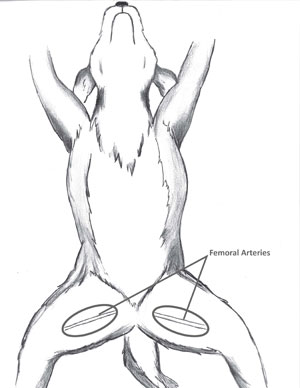CPR in Dogs
 Despite your best efforts to keep your dog safe, the unthinkable can happen. Your dog could choke on a toy, chew through an electric cord, slip out the door and get hit by a car, or collapse from heatstroke on a hot day. Any number of serious illnesses or injuries could lead to respiratory arrest (failure to breathe) and then rapidly spiral into cardiac arrest (stopped heart) and ultimately death. If your dog fell unconscious and stopped breathing, would you know what to do?
Despite your best efforts to keep your dog safe, the unthinkable can happen. Your dog could choke on a toy, chew through an electric cord, slip out the door and get hit by a car, or collapse from heatstroke on a hot day. Any number of serious illnesses or injuries could lead to respiratory arrest (failure to breathe) and then rapidly spiral into cardiac arrest (stopped heart) and ultimately death. If your dog fell unconscious and stopped breathing, would you know what to do?
CPR, or Cardiopulmonary Resuscitation, is an emergency procedure used to restore life to an animal (or human) whose breathing or heartbeat has stopped. The goal of CPR is to keep oxygen flowing to the brain and other vital organs until more definitive treatment can be obtained. CPR does not take the place of proper veterinary care. But when conducted appropriately, it can make all the difference for your dog.
The ABC’s of CPR
It is important to confirm that your dog is unconscious and has actually stopped breathing or has no pulse before you attempt to perform CPR. Take a moment to observe the situation before forging ahead. Does your dog fail to respond when you try to rouse her? Is her chest no longer rising and falling as with normal breathing movements? Is there anything stuck in her mouth, any blood or other sign of injury? Are you unable to feel a pulse? If your pet’s breathing or heartbeat has truly stopped, her tongue, lips and gums will soon start to turn blue. If you see these signs, it’s time to act.
CPR in animals and humans has three main components: Airway, Breathing and Circulation, and they must be addressed in that order. There’s no sense trying to restore a pulse (circulation) in an unconscious dog before first trying to remove the toy that is lodged in her throat (airway).
A=Airway
If your dog is unconscious and has stopped breathing, first make sure there is nothing blocking her windpipe. In cases where a dog is choking, this may resolve the problem.
Is your dog breathing?
This can be tricky to determine in an unconscious dog, but it is critical information. Stay calm if you can and take a moment to assess the following:
- Can you see the normal rise and fall of the chest?
- Can you feel exhaled breath on your hand?
- Gently pluck a tuft of hair from your dog’s coat and hold it near the mouth and nose. Is it stirring back and forth with your dog’s breath?
- Check the gums. Have they turned blue? If yes, your dog has probably stopped breathing.
What to do:
- Lie your dog on her side
- Gently extend the neck and incline the head upwards slightly
- Look in the mouth for any blood, vomitus, or foreign material and clear it away if possible.
- Pull the tongue forward. Sometimes this will dislodge an object.
- Perform a “finger sweep” of the back of the throat to dislodge objects forward onto the back of the tongue.
- If all else fails, try the doggy Heimlich maneuver described in our article on Canine First Aid.
- Tweezers or pliers may be used to dislodge a solid foreign body
- Check to see if your dog begins breathing again. If she is breathing effectively, her tongue and lips will start to turn pink and she will slowly come to. If not, proceed to then next step (rescue breathing).
- Seek veterinary care immediately, regardless of whether your dog seems to have revived completely. Unforeseen complications can arise minutes to hours after an episode of choking or respiratory arrest.
What not to do:
- Take extreme caution not to get bitten. This procedure must only be performed on an unconscious animal.
- Don’t confuse the tiny bones in the back of the throat (the larynx) with a foreign body!
B=Breathing
If the airway is clear but your dog is still unconscious and not breathing, it’s time to perform rescue breathing. The goal of rescue breathing is to provide oxygen to the lungs and vital organs until spontaneous breathing can resume. It is analogous to “mouth-to-mouth” resuscitation in people. The procedure is modified for small or large dogs to account for their different anatomy.
What to do for a large or medium-sized dog:
- Gently tilt the head upward to straighten the airway.
- Grasp the tongue and pull it forward
- Close the dog’s mouth and clasp the muzzle shut with both hands to minimize air leaks.
- Clamp you lips over the dog’s nose and exhale with enough force to expand your dog’s chest as it would with a normal breath. Inhalation should take about one second.
- Relax and let your dog’s lungs deflate normally.
- Give 3 to 5 rescue breaths and then pause to see if your dog is breathing on her own.
- If she has not resumed breathing, continue rescue breathing, aiming for 8-10 breaths per minute.
- Occasionally pause to press down on your dog’s abdomen. This will release air that may have built up in the stomach.
- Seek veterinary care immediately, even if your dog resumes breathing normally. Your vet will need to observe for complications and determine why breathing stopped in the first place.
What to do for a small dog:
- Gently tilt the head upward to straighten the airway.
- Cover your dog’s entire nose and the front of her mouth with your lips.
- Clamp the corners of her mouth shut with your hands to prevent leaks and proceed as with rescue breathing for larger dogs, above.
What not to do:
- Rescue breathing is for animals who are unconscious. Never attempt rescue breathing on an awake or distressed animal.
- Don’t attempt rescue breathing unless you have confirmed that the airway is clear.
C=Circulation
Clearing the airway and performing rescue breaths may be all that’s needed to revive your dog in an emergency. But if you’ve completed these steps and your dog is still not breathing AND has no heartbeat—or if your dog had no pulse even from the start—it will be necessary to provide chest compressions along with rescue breathing. To put things in perspective, the prognosis for a dog who has suffered both cardiac and pulmonary arrest is not favorable. The overall survival rate may be less than 5% for animals who have arrested, and of course this depends on the severity of the reason that the heart and breathing stopped in the first place. But in this rare type of emergency, you may be your dog’s best and only chance.
How to check your dog’s pulse
Checking your dog’s pulse can be a bit tricky even under normal circumstances. Practicing this at home when you’re both relaxed and comfortable will help you be prepared in an emergency. Note that a dog’s pulse rate is typically faster than that of a human and depends on size. A large dog may have a pulse rate of 70-90 beats per minute whereas a small dog’s heart may beat up to 120 times per minute.
The best place to feel your dog’s pulse is the femoral artery, which runs down the inside of the thigh from the groin to the knee. Cup your right hand firmly over the front of your dog’s right upper thigh (or use your left hand on her left thigh) with your fingertips touching the groin area. Move your fingertips back and forth until you feel your dog’s pulse.

Performing chest compressions
The principle here is the same as in human CPR courses many of us have taken along the way. Direct compression of the chest wall overlaying the heart can actually force it to passively pump blood. This is sometimes enough to sustain life until the heart can be restarted.
What to do for medium and large dogs:
- Lie your dog on her side
- Extend your elbows and cup one hand over the other. Place your hands on your dog’s chest in the area right behind the tip of the elbow.
-
Briskly compress the chest by 2-3 inches at a rate of 80 to 100 beats per minute.
What to do for small dogs:
- Cup your palm or fingertips around the area of the chest right behind the elbows
- Briskly compress the chest by 1/2 to 1 inch at a rate of 100-120 beats per minute.
Continue doing this until you feel a pulse or arrive at the veterinary hospital. Be aware that an animal who has no pulse and is not breathing despite 20 minutes of CPR is extremely unlikely to survive.
How to coordinate chest compressions with rescue breathing:
It’s best if there are two people to perform CPR. One person can give chest compressions while the other gives rescue breaths. If no one else is available to help, then you must alternate between the two. In this case, give one rescue breath for every 12 chest compressions.
Every savvy dog lover should know the ABC’s of CPR. Hopefully you’ll never need to use them.
You May Also Like These Articles:
Emergency Care for Suspected Poisoning
Why Is Chocolate Bad for Dogs?
Bloat in Dogs: Gastric Dilatation and Volvulus (GDV)
Disclaimer: This website is not intended to replace professional consultation, diagnosis, or treatment by a licensed veterinarian. If you require any veterinary related advice, contact your veterinarian promptly. Information at DogHealth.com is exclusively of a general reference nature. Do not disregard veterinary advice or delay treatment as a result of accessing information at this site. Just Answer is an external service not affiliated with DogHealth.com.
Notice: Ask-a-Vet is an affiliated service for those who wish to speak with a veterinary professional about their pet's specific condition. Initially, a bot will ask questions to determine the general nature of your concern. Then, you will be transferred to a human. There is a charge for the service if you choose to connect to a veterinarian. Ask-a-Vet is not manned by the staff or owners of DogHealth.com, and the advice given should not delay or replace a visit to your veterinarian.



